I am a betta fish lover and I have a large betta fish collection. Among them all, I am really fascinated about koi betta fish. They are a bit different from all the other betta fish by their colorations. So what do you know about this unique fish?
The color combination of koi plakat betta fish (Betta splendens) is unique and changing rapidly, with increased color pigment intensity. Their coloration resembles the famous ‘koi fish’. This species has been selectively bred, and you won’t be able to see the same color everywhere. So do you like to keep koi betta in your aquarium? I have very specific tips for you. Let’s find out the care, feeding and breeding practices of koi betta in this care guide.
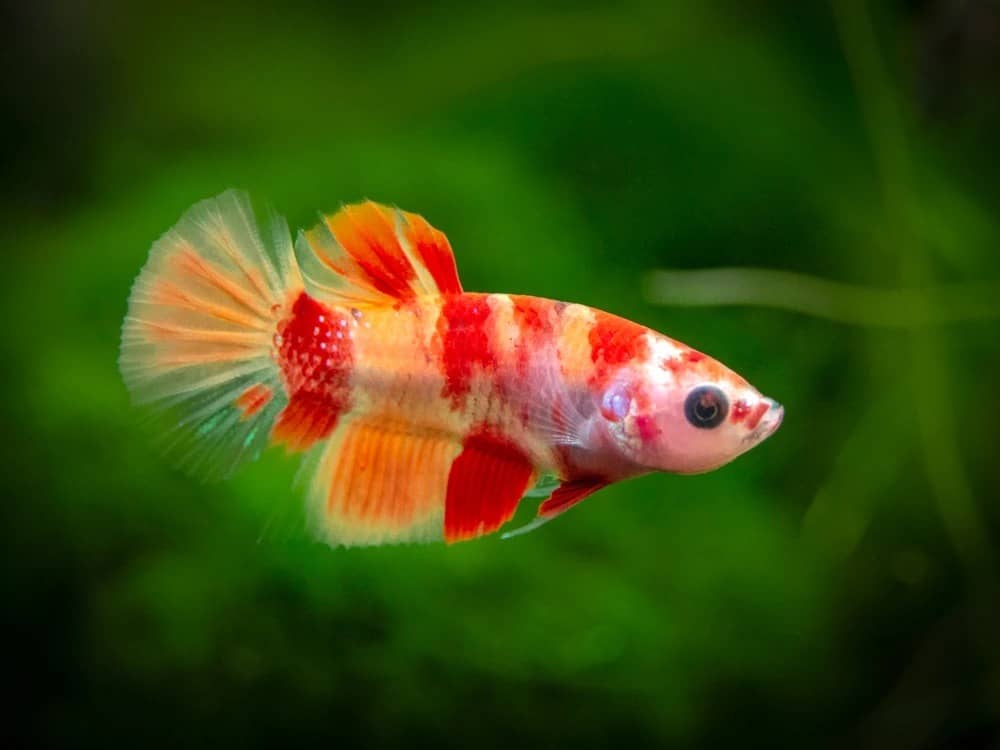
Koi bettas fish Care
Jump To
When you see betta bowls or vases, you must be thinking about how pretty and nice they are. But do you know those bettas bowls, Vases, and tiny aquariums are killing betta? But still, people buy those things on a large scale.
So, using these kinds of aquariums won’t healthily keep your koi betta. You must find a larger space for a betta at least five gallons heated aquarium, and water quality must be maintained regularly with adequate filtration. When you select a tank, keep in mind that you should choose one with a lid because betta is a jumper.
One look Care guide
| Common name | Koi betta (Betta splendens) |
| Care level | Intermediate |
| Native to | Thailand |
| Type | Freshwater |
| Color | Different colors |
| Tank size | Minimum 10-gallon tank for a pair |
| Prefered temperature | 22-26 °C |
| Other water parameters | Ammonia/ammonium (NH3/NH4): 0 Nitrite (NO2): 0 Nitrate (NO3): <10 pH: 6.5-7.5 General hardness (in dH): 3-15 dH |
| Growth rate | Meoderate |
| Temperament | Aggressive |
| Recommended tank mates | Amano shrimp, Snails, Kuhli loaches, Corydoras catfish, and Otocinclus catfish |
| Prefered food | Mosquitos, frozen foods, brine shrimp insects |
| Feeding frequency | Grown betta- two meals per day, Growing one – thrice a day maximum |
| Breeding | Easy |
| Average price | ~ $ 20 |
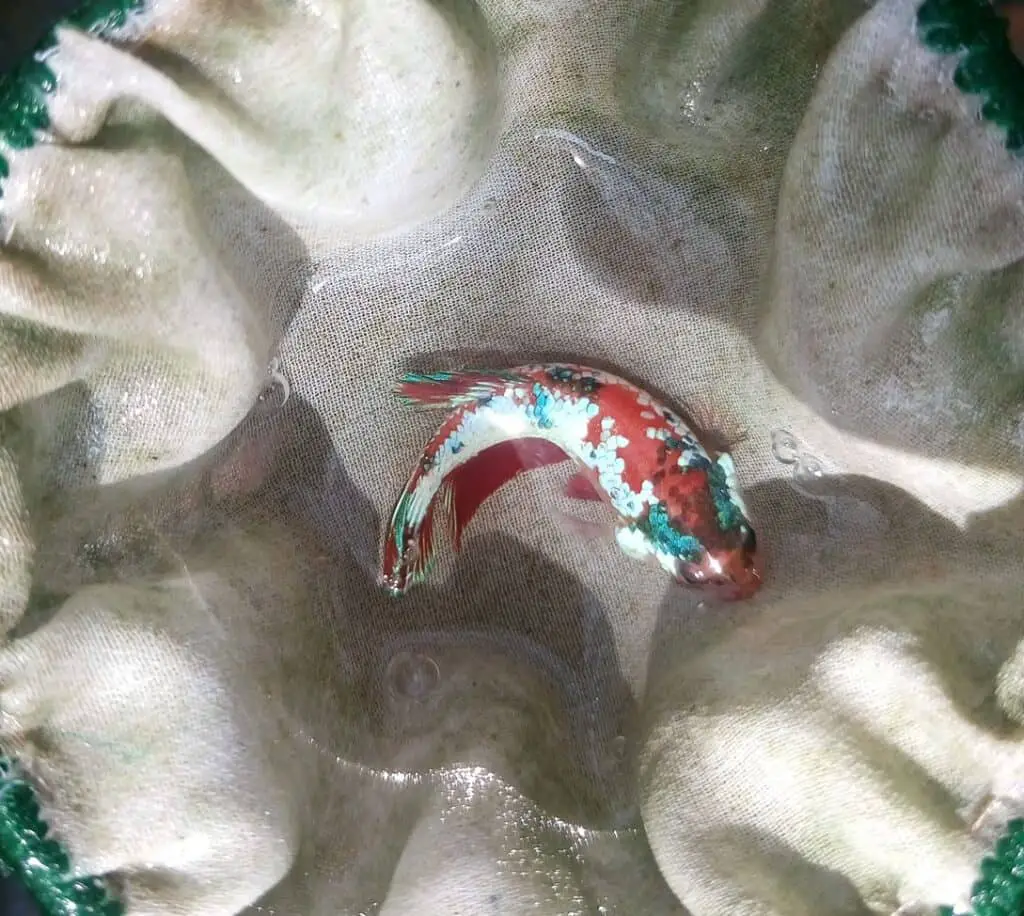
Care requirements for this fish
Most people think Koi betta can live in every kind of water since they originated from the paddy fields in Thailand. But the truth is no. Betta also needs proper care, and water should also be high quality and soft with a neutral to slightly acidic.
The water temperature should be 220 C to 260 C constantly, and you should check the temperature once a week at least. To maintain the water quality and cleanliness, you can change and clean the water twice a month. The aquarium should be quite big, and it should contain a Min. of 5 gallons of pure water. Even though the pet store sells you fish with 1 gallon of water, don’t think they can live within a gallon. Imagine if the koi betta lives in a natural environment, they can swim miles here and there. So they need space and a proper environment. Refer to the below to get a rough idea to maintain the water quality of the aquarium.
- Water Temperature: 22-26 °C
- Ammonia/ammonium (NH3/NH4): 0
- Nitrite (NO2): 0
- Nitrate (NO3): <10
- pH: 6.5-7.5 (slightly more or less is no big deal, but < 8 is best).
- General hardness (in dH): Rarely a concern unless your tap water is extremely hard. Anything between 3-15 dH (or even a little more) should be fine.
- Carbonate hardness (in °KH): Also, rarely a concern unless you’re using water that contains 0 °KH, like pure osmosis water (which you should not be doing!).
Koi betta fish tank
As mentioned earlier, small tank bowls are not suitable for betta fish even though they are pretty. If you are going to put the fish koi bettas with several tank mates, keep in mind that the betta fish tank should be spacious, or you can take the minimum tank size of 20 cm to 50 cm tanks as well or a 10-gallon aquarium for this purpose.
To maintain a proper environment inside the aquarium, you can follow a few steps.
Use some natural plants like Ana Charis, Java fern, or Java moss to provide oxygen inside the tank. And betta feels they live in a natural environment, and you can see the fish’s true behaviors as well. You must use a filter and a heater to maintain a healthy vibe inside the tank. Even with the filter, you have to change the water regularly as well. Betta mostly likes to spend their time on the water surface, and it is better to take tank mates who live at the bottom of the tank. Amano shrimp, Snails, Kuhli loaches, Corydoras catfish, and Otocinclus catfish are friendly and less troublesome tank mates for a betta in an aquarium.
How to feed them
Just like other betta fish, koi bettas are carnivorous, and since they are carnivorous, they need protein-based food, not algae-based food. koi betta lived in a natural environment and used to eat mosquitos, frozen foods, brine shrimp insects or whatever floated on the water surface.
However, usually, betta can stay without any food for two weeks. But it would help if you feed your betta as usual to maintain a disease-free healthy life cycle. These fish need better NUTRITION if you want optimal betta fish care. When you go through the supermarket or the pet shop, you can easily find the betta’s exact food. But when it comes to some flakes when they soak in the water, and those flakes go down and get stuck in the bottom, betta will not eat food stuck in the bottom of the aquarium.
There is no exact amount that koi betta have as their meals, but for a grown betta, you can give two meals per day, and for a growing one, you can feed them thrice a day maximum. But there is a tip that you can consider when it comes to providing a betta; you can see a round shape in their belly when they are full of food. But you must be careful with overfeeding because the belly area’s skin is stretching and when they eat more food, it is stretching more and more.
Naturally, a female fish’s belly is any way around as well. When you find food for your betta, freeze-dried food, live food, and frozen food also can be given. You have to be concerned about the more protein food when you find food for them as well.
Colors and types of this koi
Do you know that the koi betta name has been created because of the patterns of their body? When we consider the colors and types of betta, there are a few colors you can see. The most popular and typical color of the betta fish is steel blue, Royal blue, and bright blue. And refer below to get to know about the bettas’ colors and types in general. And do you know marble betta is also a type of koi betta? Let’s find out a bit about marble betta.
What is marble betta?
Marble betta is one of the exciting types of koi betta. It is the name used to identify betta fish with a marble color pattern in the body. The most interesting feature about them is that they change color during their lifetime. This unique phenomenon is caused by a special gene called “Transposons or Jumping gene”. Fish have patches on their body and fins which contain unique pigments, which cause color variation.
These color pigments are not unique to marble betta (but every betta fish does not change color like marble betta). The color variation in marble betta is not as sudden as in octopus or squid. It seems to be a gradual process. In the native environment, when they are first found, they are black and white in color. But after so many experimental breedings, now there are marble species with every shade of color imaginable.

What is the jumping gene?
Transpose of the jumping-gene was a recent discovery by a group of scientists. They observe this special type of gene (or DNA sequence) change its position within the genome (as name jumping). There are pros and cons of these jumping genes. Their importance in the evolutionary process is definitely an advantage. But sometimes, these jumping genes can mask the function of another gene, which can cause a negative impact on an animal.
How Jumping gene affect marble betta?
As the name implies, this gene can change its location, unlike other genes. This can happen in several ways. As explained earlier, the jumping-gene can mask a gene expression by jumping into its position. For example, the red color of a fish is the result of a specific gene. If the jumping gene changes its location to the red color gen’s position, its expression is masked, and the red color of them can be disappeared.
This is happening in marble fish. Jumping genes mask the expression of color, displaying genes and causing them to lose color. But the jumping gene does not stay in one place for a long time. When the jumping gene decides to move into another place, the masking stops, and colors start to appear again in the fish.
Marble betta vs koi betta
Marble betta is a type of koi bettas. They have the same type of patchy appearance in their body. But every koi betta can not change their color. This color-changing ability of marble betta can be notorious for some aquarists. But there may be marble betta enthusiasts who enjoy the disappearance and coming back of the color.
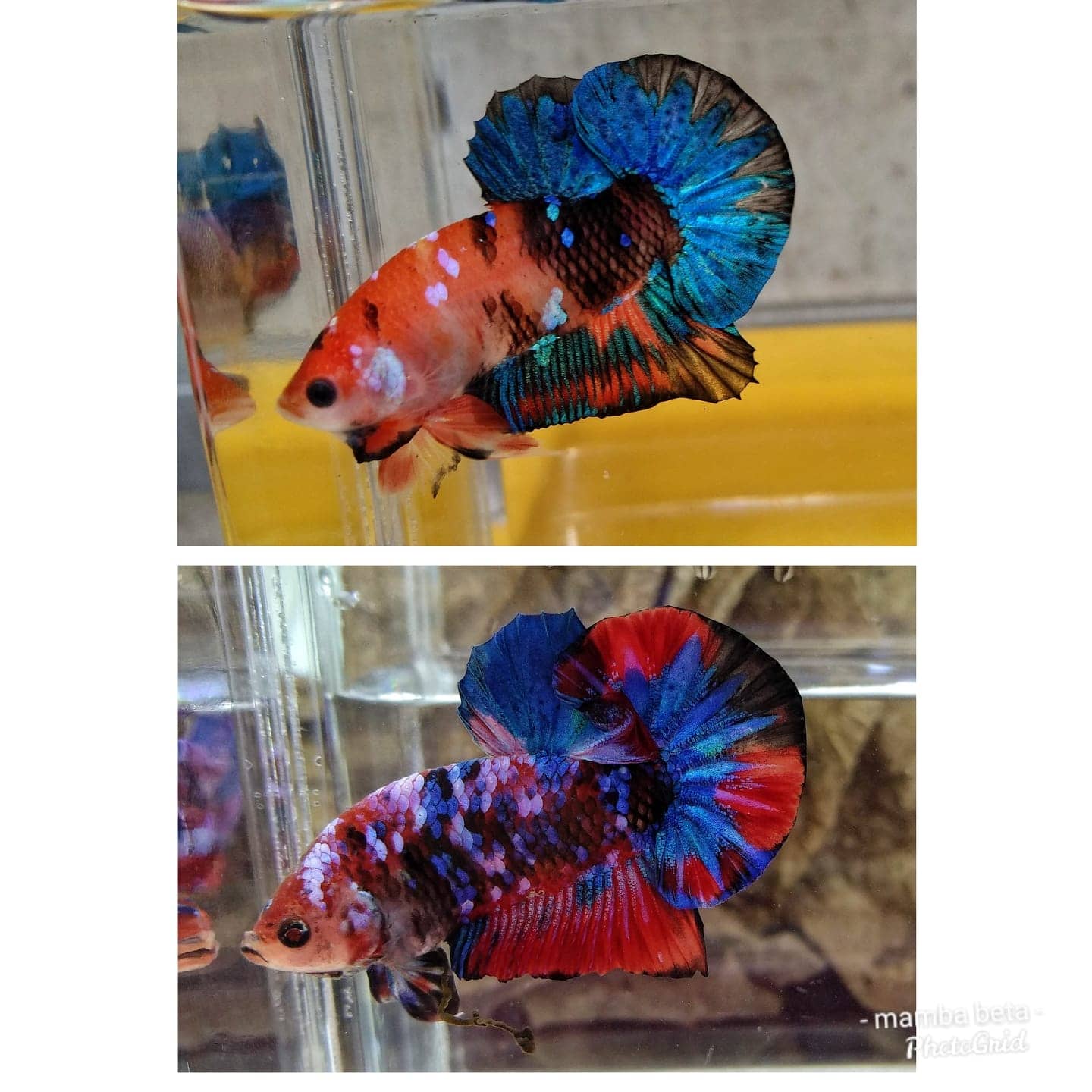
Do they change color?
Yes, they change color. Bit color change with their age is slow. Sometimes fast color changes can occur due to health problems or changes in water quality. They do not change color as Marble betta fish because Marble betta is a type of koi bettas but all marble bettas are not koi bettas.
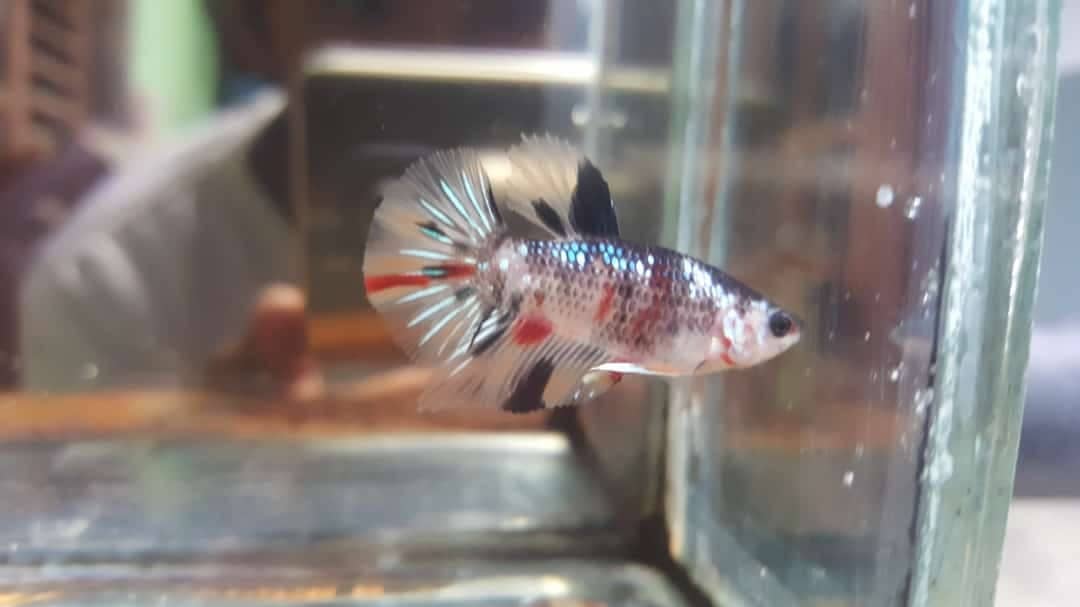
The basic color pattern of this fish
When considering the color patterns of koi betta fish there are 6 types.
- Marble
- Fancy koi betta fish – Marble with 3 or more colors.
- Galaxy koi betta fish – Marble with partial iridescent scaling.
- Candy koi betta fish – Marble with black, red, & blue or yellow.
- Tiger koi betta fish – Yellow-bodied with black or blue marbling.
- Nemo koi betta fish – Marble with orange, red, and black.
- Samurai koi betta fish – Marble with partial dragon scaling.
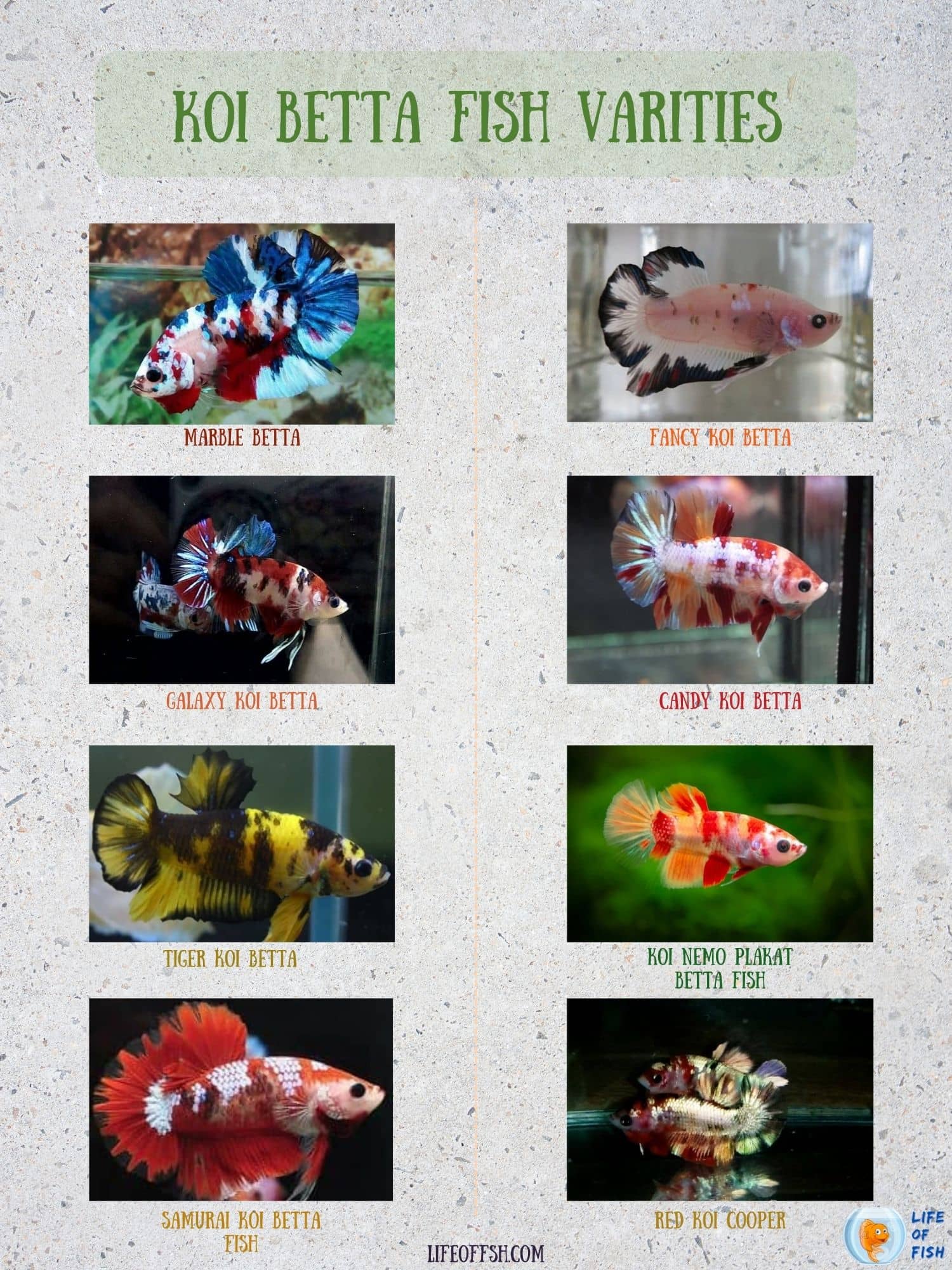
How to Breed this fish
You have to keep in mind that you have to consider four categories when you breed koi bettas: mutation, colors, and patterns of them. So, with these elements, you can also have different and various kinds of betta fish. You can simply know when your female betta is ready to be receptive, her color will get darkened, and she will display her barring pattern as well.
Female koi betta egg-laying
They lay eggs, and they can lay around 10 to 40 eggs at once. The male betta will make the bubble nest to keep the eggs before the female betta lay the eggs. When female betta fish are done laying, male betta will take care of the eggs, and it will take three days to hatch those tiny eggs, and baby betta will come out. They are called “fry” when they are freshly born.
Are they Aggressive?
For this, we can simply say, “Yes.” Well, mainly the male koi betta fish is more aggressive towards other male betta, and they will end up in their fights by killing each other in the end. The funniest thing is these males are aggressive for their own reflection sometimes. You should not keep two male bettas in the same aquarium.
And there are periods when male betta are aggressive towards female betta fish as well. When the female betta tries to get closer to the bubble nest, you can obviously see how male betta fish will change their nature.
And finally, these male bettas are aggressive toward certain tank mates as well. galaxy koi betta needs adequate hiding space in the aquarium.
How does this betta sleep?
Scientists believe that fish also get some rest or sleep like humans and other animals as well. When it comes to betta, they also sleep like others, but it is different. Betta fish are light sleepers.
There are a few reasons for that too. When they sleep tight, they think they are not safe from another one, and betta who used to live in paddy or a natural water stream could have been attacked by another fish or the same breed of birds. Therefore even with a small sound or a movement, they wake up so easily. Betta is active in the daytime, and they also prefer to rest at night.
When they sleep, their color is fading away, and it is applicable for betta as well. When they are fully awake, you can see the bright, rich color over their skin and fins; when betta sleep, they breathe too. If you get a closer look at them, you can see it draws water from their mouths out through the gills, and they use less oxygen when they sleep. If you see betta floating vertically, don’t worry, it is having a good nap.
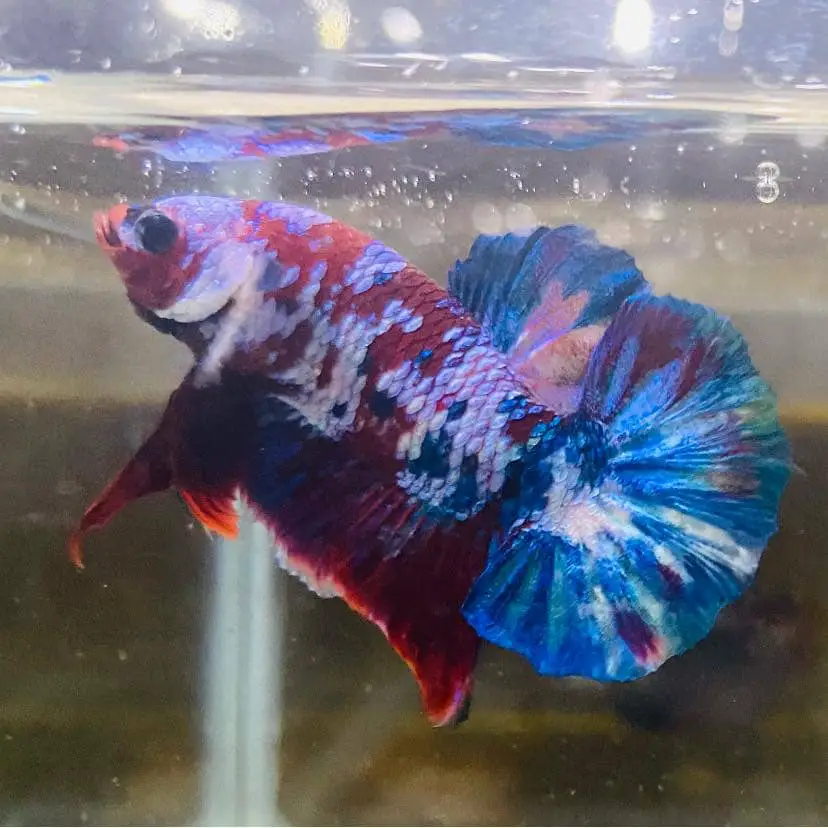
How fast and how big do these bettas grow?
These koi betta fish species are fully growing when they become older and approximately when they are around six or seven months.They also need good care to grow
But as mentioned, these situations vary with caring and with the environment as well. After eleven or twelve months, a koi betta fish is approximately 2 to 2.5 inches long, and they are fully grown. With the right condition, bettas can grow up to 3 inches as well. The largeness of these species totally depends on their age and the care that you give them.
The lifespan of this betta fish
Well, with reasonable care and a proper environment, a straightaway, lifespan can be two to three years. But keep in mind this is so variable with so many other factors too. It would help if you kept in mind that when you buy a betta fish from a pet store, it’s already 6 or 7 months old, and you have left only two or two and half years with the betta fish.
Common Health Problems of koi betta
- Septicemia
- Columnaris
- Slime Disease
- Velvet
- Fin Rot
- Swim Bladder Disorder
- Popeye
- Constipated
- Tumor/Cyst
- Dropsy
- Lice
- Hexamita
- Fungus
- Internal Parasite
- Ich
- scale loss
Related quesions
Can betta and koi fish live together?
Well, the answer is simply no. Koi is bigger than a koi betta fish, so if they live together in the same aquarium, most probably koi will end up eating the betta fish. You can have a few koi betta fish in a tank, but three or four female koi betta fish with one male is an ideal combination because two males are going to fight with each other.
What is galaxy koi betta?
They are one of the most famous betta varieties. They are marble colored with partial iridescent scaling.
How to Identify Koi Betta fish (Betta splendens)?
Simply you can see its body-based with cellophane and red and black spots on its body.
How does koi betta acclimates?
Automatically koi betta fish try to adapt to the freshwater within 5 to 8 min. But if it is a tank, it is better to keep a heater to take the water level on the same basis.
Do koi betta fish jump out of the tank?
Well, yes, Koi betta is a jumper. They can jump to two to three inches approximately.
Where can you buy koi betta?
You can buy koi betta in most aquariums and local pet stores. You can also purchase them from Petco. The average price sits around $ 20. You can search the internet for more information.
What do you do after your betta fish dies?
Take out the fish as soon as possible. Wrap it in paper and keep it in the freezer for a bit, helping preserve the body. Then bury them.
Also, see our guide about Betta imbellis The Peaceful Member Of The Aggressive Family
Black Orchid Betta Care | Anabantoids | All You Need To Know
